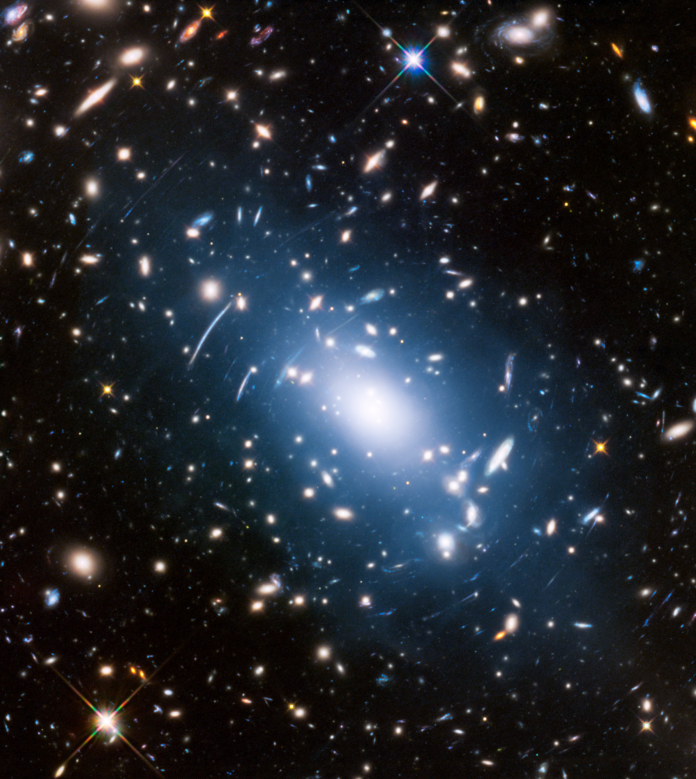The search for dark matter requires all of the best models, theories, and ideas we can throw at it. A new paper from Julia Monika Koulen, Stefano Profumo, and Nolan Smyth from the University of California at Santa Cruz (UCSC) tackles the sizes and abundance of one of the more interesting dark matter candidates – primordial black holes (PBHs).
In studies of the early universe, the formation of the first stars marked a milestone that shines a light on the rest of time, both figuratively and literally. Astrophysicists call those first stars Population III stars. In another wonderfully strange twist of astronomical naming, they are called so because they were the third type of star to be discovered, with young “metal-rich” stars like our Sun making up “Population I” and older, “metal-poor” stars making up “Population II”. Population III stars, on the other hand, would be completely metal-free since the fusion process required to create the elements considered “metals” in stars (i.e. everything but hydrogen) would not have formed yet.
Since we have never directly observed Population III stars, we know very little about them. But, we can still simulate them, and also their environment to better our understanding both of them and of the universe that they were born into. That is what the paper from the UCSC researchers attempts to do. We believe they formed in an area of space called a “minihalo”, which was primarily composed of dark matter, so scientists have been searching for what those minihalos were actually made out of.
Fraser discusses PBHs and where they came from.
PBHs are one of the prime candidates, and could have either composed, or at least interacted with, these dark matter halos. Understanding the effect of these singularities on the formation of the earliest stars could hold a clue as to whether they are a good candidate for the larger existence of “dark matter” that we still see influencing the gravitational evolution of the universe today.
Simulating them, though, is harder than it sounds. The UCSC researchers used a software package called GIZMO to simulate two main components of the early universe – hydrodynamics and an N-body gravitational scenario. Hydrodynamics attempted to capture the process by which dust and gas affected the formation of the earliest stars, while the N-body attempted to solve for the gravitational influence of so many large bodies moving quickly close to each other.
The simulation started very very early in the universe and used the Lambda-Cold Dark Matter model that scientists use as the standard model of Big Bang Cosmology, with another added library called GRACKLE to handle gas cooling dynamics, which again have a major impact on the formation of stars.
Fraser discusses how we can detect PBHs with Dr. Celeste Keith
At the end of all the simulating, the researchers found two very distinct roles that PBHs could play. They could either act as seeds, causing the formation of stars much earlier than otherwise predicted. Or they could act as suppressors, causing star formation to take much longer than originally predicted.
If the PBHs in the early universe are “massive” (i.e. 100 or more times the size of the Sun), then they consistently seed the early universe more quickly with stars. They do so by increasing the intensity of density fluctuations, which in turn creates more of the dark matter minihalos where stars form. Notably, if there are a lot of massive PBHs early in the universe, the first stars could start strikingly earlier than current models would predict – a nice, falsifiable prediction that could be disproven once we gather more data on Population III stars.
Smaller PBHs – those with around 10 times the mass of the Sun – play a more complex role in the early universe. If there aren’t very many of them, these PBHs actually suppres the formation of stars. They do so by “tidal heating”, whereby they increase the temperature of the gas that would typically cool and then collapse into the first stars.
Fraser goes into more detail about PBHs
On the other hand, if small PBHs were plentiful in the early universe, they would again speed up star formation, this time by their cumulative gravitational pull, known as the Poisson effect. In effect, they operate in a similar way to massive PBHs – as a center of gravity for gas and dust to coalesce around.
The great thing about all of these simulations it that they offer different ways to interpretation the data that we will eventually collect about the earliest stars. If they form early, it could be either because of supermassive PBHs or an abundance of smaller objects. However, if the first stars are found to have formed later, that makes a good argument for relatively small PBHs, and all the implications that might have for the search for dark matter.
Ultimately, we won’t know until we collect more data. The James Webb Space Telescope is currently our best bet for how we will be able to do that, but it needs to get the observational time to be able to focus on that data collection. Other observatories, like the Square Kilometer Array (SKA), could revolutionize 21-cm cosmology, which would be key to seeing back far enough into the universe to see when the first stars officially lit up. When we do finally get that data, the predictions made in this paper, as well as dozens of others, will finally be put to the test.
Learn More:
J. M. Koulen, S. Profumo, & N Smyth – Primordial Black Holes and the First Stars
UT – Where are All the Primordial Black Holes?
UT – A New Way to Detect Primordial Black Holes Through Their Hawking Radiation
UT – Could Primordial Black Holes Be Hiding in Plain Sight?


